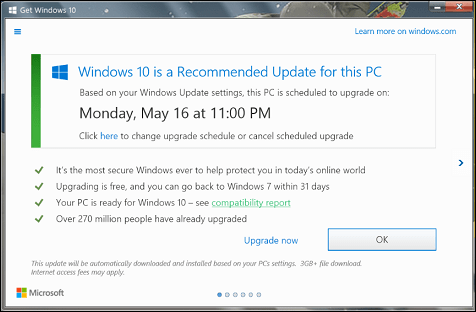Today, Microsoft published a Knowledge Base article (KB3095675) with information about the changes in the Windows 10 Upgrade Notification. The report details instructions how to manage, schedule, and disable the upgrade.
Microsoft Guides Users for Cancelling Automatic Upgrade to Windows 10
We have already covered some of the information discussed in the article, which describes how to use the Get Windows 10 app (GWX) itself to disable the upgrade. Since then, modifications have been made to GWX, and it is more verbose about when it will happen. This still does not necessarily give users the peace of mind that they can safely opt-out of the upgrade, though. Part of the reason why Windows 10 is installing without consent, is due to changes in delivery over Windows Update. Instead of an optional upgrade, Windows 10 is now provided as a Recommended Update. Users can manually modify this setting by opening Control Panel, Windows Update, Change settings then uncheck Give me recommended updates the same way I receive important updates.
This notification means your Windows 10 upgrade will occur at the time indicated, unless you select either Upgrade now or “Click here to change upgrade schedule or cancel scheduled upgrade”. If you click on OK or on the red “X”, you’re all set for the upgrade and there is nothing further to do. When you close this pop up, your PC will upgrade at the scheduled time. Based on customer feedback, in the most recent version of the Get Windows 10 (GWX) app, we confirm the time of your scheduled upgrade and provide you an additional opportunity for cancelling or rescheduling the upgrade. Source
With less than three months to go, users need to consider seriously if they want to pass up on the free offer. At the end of July 2016. If you decide you want to upgrade, you will have to pay $119 for the Home version or $199 for Pro. Windows 10, so far, is off to a great start, with 300 million systems already running the OS since its launch last year. I have committed to upgrade. A lot of the severe bugs in Windows 10 have been ironed out over the past nine months. This is due to constant updates on a near weekly basis. The Anniversary Update expected this summer refines Windows 10 even more, but only users who have already upgraded will get the update for free. When you upgraded from a previous version of Windows, what happened is the hardware (your PC) will get a digital entitlement, where a unique signature of the computer will be stored on Microsoft Activation Servers. The Windows 7 or Windows 8 genuine license you were previously running will be exchanged for a diagnostics key. Anytime you need to reinstall Windows 10 on that machine, just proceed to reinstall Windows 10. It will automatically reactivate. So, there is no need to know or get a product key, if you need to reinstall Windows 10, you can use your Windows 7 or Windows 8 product key or use the reset function in Windows 10. then https://www.groovypost.com/howto/create-windows-10-bootable-usb-flash-drive/ Joseph Comment Name * Email *
Δ Save my name and email and send me emails as new comments are made to this post.


